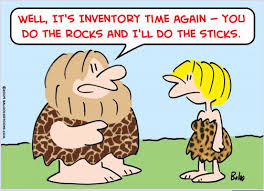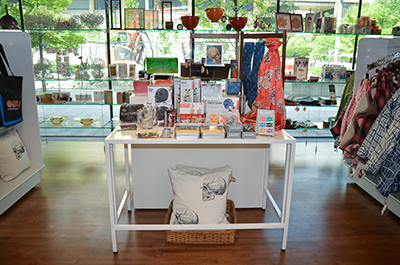A customer wanders in to a museum’s retail store. He is inspired by the art exhibition he just visited and wants to take something home to commemorate his experience. Enjoying the ambient music as he shops, he eventually purchases a magnet featuring a photo of the artist, a coffee cup with an image of one of the artist’s paintings on the front and the exhibition catalog featuring a full set of color plates of the artist’s best works. The customer is probably unaware that all of his purchases, and even the music he listened to while he shopped, contain copyrighted works protected by federal law.
As the above scenario illustrates, copyrighted works are all around us. As a retailer, it is important to know some basic elements of copyright law in order to avoid getting into hot water for infringement under the federal Copyright Act. To begin with, a copyright is an intellectual property right to an original creative work. Just like a title document can be used to defend tangible and real property (like a car or land) from trespassers, a copyright can be used by an artist or author to defend his or her original creative work from infringement by others. Like a title, the copyright to a piece of work can be sold and transferred. However, unlike a title to a piece of land, physical ownership of an original work is different from ownership of the copyright corresponding to that original work.
For example, when an artist sells her painting to a museum, she still retains her ownership of the painting’s copyright. The museum has the right to exhibit the painting, loan it out or resell it. However, the museum may not copy or otherwise reproduce images of the painting without licensing the copyright from the artist first. This means photographs or digital images of the painting cannot be used in advertising, on the museum website or on postcards and t-shirts in the museum shop without prior permission from the artist. In addition, because she owns the copyright, the artist may license the image of the painting to another person (or museum) for use on products or in books even though she no longer owns the actual painting; she does not need to ask the permission of the museum to exercise her copyright.
Are you confused yet? If so, you are not alone. Consider the following nine copyright myths that can arise in a retail setting when developing a product for sale or using images to advertise an existing product.
MYTH #1: “If I use only a small portion of a work, say, 10 percent, it is not infringement.”
REALITY: There is no set amount of a work that is automatically safe to use. Lawsuits have resulted from something as seemingly innocent as the unlicensed use of a single line of text from a Faulkner novel in a Woody Allen movie (Faulkner Literary Rights LLC v Sony PicturesClassic). It is logical to think that if you only use a very small amount of a copyrighted work, such as 30 seconds of a song or 20 words from a published book, you are “in the clear.” However, even using small portions of a copyrighted work may infringe a copyright holder’s rights.
MYTH #2: “If a work is not marked with a copyright notice (©), or is not registered, then I can use it however I want.”
REALITY: Copyright notice and/or registering the work with the U.S. Copyright Office is completely optional. Since 1989, a copyright attaches to fixed or tangible original creative works automatically—no special actions are needed for it to be protected. This being said, a copyright notice informs others of the identity of the work’s owner, which can be handy if you want to know who to approach for a license.
MYTH #3: “There is an exception for nonprofit museums—right?”
REALITY: Wrong. Many think that because a museum operates as a nonprofit entity that it is not subject to the same copyright rules as private companies. The reality is that copyright law applies to everyone equally, and there is no special exemption or exception for museums.
MYTH #4: “Since the museum purchased the artwork, the museum now owns the copyright.”
REALITY: This is another common misconception. Copyright law makes an important distinction between owning the physical embodiment of a work and owning the copyright. The two are usually divided, so that the museum may own the artwork, but will still have to ask for permission from the artist to use images of it for commercial purposes. For example, it is permissible for the owner of a physical work (like a painting) to display it in an exhibition, sell it to another or even destroy it. However, unless the artist has assigned his copyright in writing to the owner of the work (in this example the museum) the right to reproduce images of the artwork for things like retail merchandise or advertising is off limits without a license. Of course, copyright protection does not last forever. However, determining whether or not a work is still protected by copyright (also called falling into the “public domain”) is equally challenging.
MYTH #5: “What if I properly acknowledge the copyrighted material when I use it, inserting the © symbol? Isn’t that enough?”
REALITY: No. Acknowledging the source of copyrighted material does not substitute for obtaining permission. If you do not seek permission for the use of copyrighted materials, you risk copyright infringement. Copyright infringement is not like plagiarism; you cannot remedy it by attribution.
MYTH #6: “If a work is already freely distributed online it must be okay to use.”
REALITY: The pace of technology makes it remarkably easy for anyone to put copyrighted images on the Internet, even when they are clearly not licensed to do so. A simple Google search of “Pablo Picasso images” or “Andy Warhol paintings” yields literally millions of image hits. It is easy to see how confusion about copyright ownership results. In short, just because the image (or even a part of the image, such as a close-up) is out there on the Internet, it is still protected by copyright and you must seek a license before using it for most commercial purposes.
It is also important to note that a copyright holder, such as an artist, does not forfeit her copyright by posting her own work on the Internet. Consider that many modern artists use the Internet to sell physical copies of their work. This would be impossible if they could not post the pictures without fear of losing that copyright.
MYTH #7: “Well, at least I can take and use images of museum patrons and other individuals on my retail products or advertising without asking permission—as long as they are not celebrities.”
REALITY: This also is a common mistake that retailers make, especially with advertising or promotions on the web. While each state has its own rules about this issue, generally every individual has a right to control how his or her image or likeness is being used. You do not have to be a celebrity to have such a right, which is commonly known as the “right to publicity” and varies from state to state. In short, if you want to use models or images of patrons for merchandise or publicity, a written release from that person is a must.
MYTH #8: “Copyright only protects things like artwork and books. Playing a CD or the radio in the museum shop will not get me in trouble.”
REALITY: Copyright protects any fixed or tangible original creative work. Such works include paintings, sculptures, books, music, movies, choreography, dramatic works, computer programs and even architectural works. Playing a CD or the radio at a venue that is open to the public, such as a museum store, constitutes what is legally a “public performance” under U.S. copyright law. The right to publicly perform a copyrighted work (and this includes playing a recording in public) is one of the exclusive rights enjoyed by the copyright owner. As a result, someone who wishes to publicly perform such works must generally seek permission from the copyright owner(s) of the works.
MYTH #9: “Well, copyright is certainly difficult to navigate, at least my museum’s name and logo are protected.”
REALITY: Not so. A copyright protects fixed original creative works; a registered trademark protects and identifies a corporate enterprise. Because they seem similar, copyrights and trademarks are often confused. A trademark (or service mark) is a word, phrase, symbol or design that identifies or distinguishes a company or product, and can be indicated by TM or ®. Essentially, a trademark is a brand name designed to identify the source of goods. While similar to copyright, trademark is a different concept and has its own set of registration rules and procedures.
Conclusion
Copyright law is complex and nuanced. While copyright does not last forever, the rules are complicated enough that you should not try to navigate them on your own. Museum retailers would be wise to stay especially vigilant when developing and selling retail products that feature copyrighted works. When in doubt, it is always appropriate to seek help from the museum’s legal counsel.
Author Carlotta Ramirez is an attorney and administrator at The Museum of Fine Arts, Houston, specializing in legal compliance as well as the formulation and implementation of museum policy. Her daily work at the museum spans a variety of legal practice areas, including contracts, intellectual property, trusts and estates, and tax.








